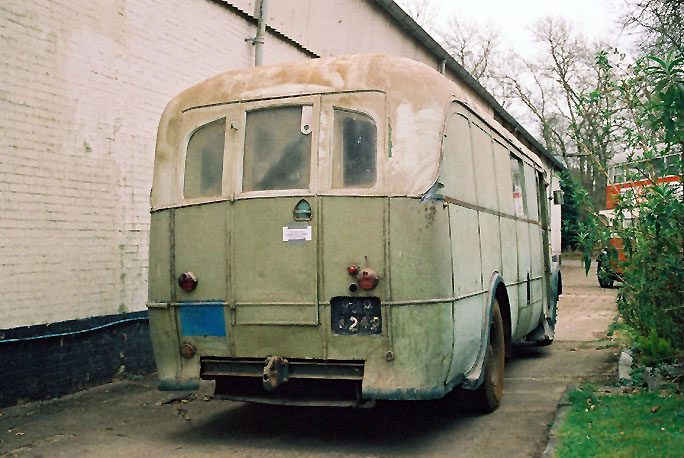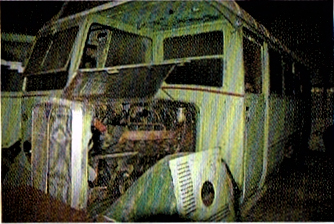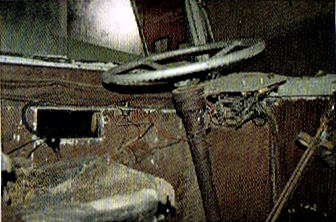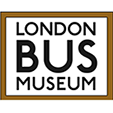T357 (GN 8242) : new in January 1931 to Queen Line Coaches, Baldock, Herts
-
- Chassis : AEC Regal I
- Engine : AEC A145 7.4 litre petrol
- Gearbox : manual
- Body : rebodied in 1935 with Weymann 29-seat body, later upseated to 30, front-entrance
- Vehicle Classification: T – code is believed to have simply been the next available letter at the time the type commenced production .
Withdrawn : July 1945 (14 years)
Acquired by Museum : 2003
Status : on display but awaiting restoration - T357 Appeal - donations welcome
![T357 at Redhill Road [Ian Jackson] T357 at Redhill Road [Ian Jackson]](https://www.londonbusmuseum.com/wp-content/uploads/2011/07/T357.IanJackson.jpg)





The chassis of this coach was new to Queen Line Coaches of Baldock in January 1931 and was fitted from new with a rather old-fashioned 31-seat, rear-entrance coach body built by London Lorries. It was finished in a light greenish-cream livery. In April 1933, the Queen Line company was absorbed into Green Line Coaches Ltd and the coach was allocated fleet number T357, passing to London Transport, still as a Green Line coach, in July that year.
In 1935, T357's old body was discarded and it received a new Weymann metal framed one, a front-entrance body with 29 seats. It entered service in its new form at Watford garage on Green Line duties but was downgraded to a bus the following year. In 1938, T357 received a seating increase to 30 and moved to Hertford Country Area garage. In 1942, it was one of many London Transport single-deck buses to have its seating configuration converted to a peripheral arrangement, in this case 27 seats along the sides, which allowed 20 standing passengers, a vital increase in capacity needed to cope with the large rise in passenger numbers on bus routes serving factories engaged in the war effort.
The shortage of petrol in WW2 saw the bus converted in 1943 for "producer gas" operation, whereby it towed a trailer which burned anthracite, producing gas to power the engine. It was one of very few LT single-deck vehicles to be selected for conversion. The seating arrangement was also changed to a perimeter layout to permit a greater number of standing passengers. At the same time, it lost its green livery in exchange for a drab wartime grey and was transferred to Addlestone garage in Surrey for service on the routes serving the Vickers aircraft factories. One of the Vickers satellite factories was the building in Redhill Road, Cobham which, many years later, became the Cobham Bus Museum!
Towards the end of 1944, T357 was converted back to petrol and, in July 1945, was requisitioned by the Allied Control Commission and transferred to Berlin.
After military ownership the AEC Regal T357 was left in an Allied army surplus depot in the Dunkirk region, together with many lorries, other vehicles and equipment, as well as a dozen other Regals of London origin. When new regulations allowed the sale of the vehicles to commercial owners in Spring 1946 many of these former Allied AEC’s found their way to French civilian owners.
One of these was T357, sold in January 1947 to Fernand Delambre at Bucquoy, a small village near Bapaume, Pas-de-Calais. Delambre ran a road construction company and the bus was used top transport workers. T357 was registered in the Pas-de-Calais department with civil licence plate 3538 NB as a 40-seater, equipped with petrol engine no. 2462.
In July 1949 T357 found a new owner in a once, well-known bus company Autocars Fouache at Brébières, near Douai. At that time they were the owners of a small fleet of former London Regals: T108, T239 and T385 (purchased from a Metz army depot). All these buses were used in transport contracts for the coal mines in the Douai and Lens region. Fouache replaced the petrol engine for a more efficient diesel. In 1950, plate no. 3538 NB was replaced by 228 AY 62 as a result of the introduction of a new vehicle registration system.
(In October 2015 the still family-owned Autocars Fouache concern was sold to Keolis and reportedly dissolved in November 2023).
Two years later, in August 1951, T357 passded to a third French owner, Paul Dourlens (Autocars Dourlens) at Bruay-en-Artois in the Béthune region, where use for miner transport continued.
With the increasing availability of new vehicles, by early 1956 T357 was taken out of service. On April 30 1956 it was transferred by the departemental vehicle administration to Jean Galczynski, an electrician living in Calonne-Ricouart, who intended to convert it into a mobile caravan. When M.Galczynski relocated to Millam, near St. Omer in the Pas de Calais, the AEC was reregistered again, this time to 714 BV 59 as Millam was in the Département du Nord of France.
After M. Galczynski's death, the bus fell into disuse until discovered in 2003 by Danny Chabaud, a French bus enthusiast. He alerted Roger Stagg of the Cobham Bus Museum by phone of the availability of the bus. M. Galczynski's widow indicated that her husband had always wished to see the bus properly rebuilt and she was keen for it to return to Britain for restoration.
David Kinnear, Bill Cottrell, John Bedford and Graham Smith, all LBPT Members organised and participated in the evaluation and consequent repatriation of the bus after viewing it in its farm barn location in Millam area near St. Omer in the Pas de Calais, in northern France. Transportation across the Channel was accomplished with the use of a low-loading truck / trailer combination and ferry.
On Friday 14th March 2003, the bus re-entered the grounds of the former Vickers building, by then home to Cobham Bus Museum, over 58 years since it had last been there!
The bus is in need of a full restoration but seems to have remained structurely sound as it has been under cover since the 1950s. The T357 Appeal was launched to raise the funds for restoration, some of which will be undertaken by an outside professional firm and some within the Museum's own workshop. Donations welcome!
Our sincere thanks are due to Albert van Huizen for providing the post-war history of T357 in France.
Photos:
- top-right, top-left and below: T357 after arrival at Redhill Road in 2003. T357 bears its French registration, 59 indicating the Nord departement in the Nord-Pas de Calais region of northern France. [Ian Jackson]
- lower: side and cab views showing the considerable amount of restoration work required
